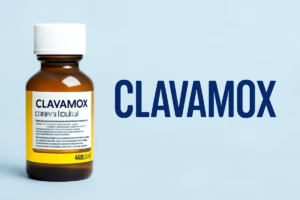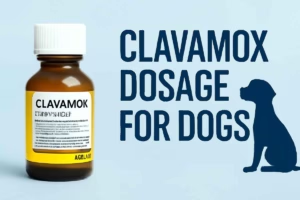Introduction to Clavamox for Dogs
Clavamox is a broad-spectrum antibiotic commonly used to treat bacterial infections in dogs and cats. It is made up of amoxicillin and clavulanate potassium, which work together to target and combat various bacteria. This medication is particularly effective for treating skin and soft tissue infections, as well as urinary tract infections.
General Description of Clavamox.
When it comes to treating infections in dogs, Clavamox is often the go-to antibiotic. This antibiotic is a combination of penicillin, amoxicillin, and clavulanic acid, which creates a broader spectrum of action to target a variety of bacteria. I’ve personally used Clavamox for my dog when he suffered from a respiratory infection. The results were impressive, as it worked effectively to treat soft tissue infections, urogenital infections, and even skin infections.

The added benefit of this treatment is how it addresses common bacterial infections that other treatments may not reach. This combination of amoxicillin and clavulanic acid ensures that your dog gets the proper treatment without unnecessary side effects, making it a preferred choice in veterinary medicine for a wide range of issues. Just remember, getting the dosage right is key to ensuring effectiveness, especially in more severe cases.
What is Clavamox?
- When your dog is diagnosed with a skin infection, like rash-like dermatitis, or perhaps dealing with soft tissue infections due to wounds or abscesses, Clavamox can be a lifesaver.
- I’ve had firsthand experience with Clavamox when my dog had a dental infection that wasn’t responding to typical treatments.
- After getting the FDA-approved Clavamox, the infection cleared up quickly.
- This antibiotic combines the power of amoxicillin and clavulanic acid, making it effective for treating a wide range of bacterial infections.
- It’s essential, though, to ensure you’re following the correct dosage—as this determines the effectiveness and ensures the infection doesn’t resurface.
- Keep in mind, this treatment can tackle even stubborn infections that other methods might miss.
What is Clavamox Used to Treat in Dogs?
When it comes to treating bacterial infections in dogs, Clavamox is a broad-spectrum antibiotic that targets both Gram-positive and Gram-negative bacteria, as well as aerobic and anaerobic bacteria. I used Clavamox when my dog had a bacterial infection that was resistant to other medications. This antibiotic combines amoxicillin trihydrate with clavulanate potassium (a potassium salt of clavulanic acid), creating a potent, potentiated penicillin.
The active ingredients work together to overcome bacteria that are typically resistant. For instance, amoxicillin trihydrate is a powerful semisynthetic antibiotic, but it’s not resistant to β-lactamase enzymes, which is where clavulanic acid, as a lactamase inhibitor, comes into play. The combination of these ingredients ensures that Clavamox can tackle tough bacterial strains and effectively treat a wide range of infections in dogs.
If you’re considering alternatives for your dog’s infection, you can also look into Cephalexin for Dogs Dosage for comparison.
How it works
When you’re treating your dog for infections, Clavamox is often the go-to antibiotic. This treatment is especially effective due to its combination of amoxicillin and clavulanic acid, making it a stronger alternative than just penicillin or amoxicillin alone. I’ve seen firsthand how Clavamox works wonders for my dog, especially when faced with tougher bacteria that didn’t respond to other medications. For example, this antibiotic is effective against a wider spectrum of bacteria, including those resistant to many penicillin-based antibiotics.
One of the key reasons Clavamox is so effective is that clavulanic acid works by fighting a compound released by bacteria from the Staphylococcal family, making it a top choice for soft tissue infections, skin infections, and respiratory issues. However, it’s crucial to get the dosage right; too much or too little can affect the treatment’s success, so consulting your vet about the proper dosage is essential to avoid complications.
Clavamox Dosage for Dogs
When it comes to treating infections in dogs, Clavamox is widely recommended due to its ability to tackle a wide range of bacterial issues. The recommended dosage for dogs is universal: 6.25 mg per lb of body weight, given twice a day. However, it’s important to note that the length of Clavamox therapy depends largely on the dog’s underlying condition. For example, dogs with skin abscesses often need only 5 to 7 days of treatment, while a more severe infection like deep pyoderma may require up to 21 days of Clavamox use.
However, more severe infections like Deep Pyoderma may require up to 21 days.

I had to use Clavamox when my dog suffered from a urinary tract infection, and the dosing lasted around 10-14 days, which was just right for this condition. Keep in mind that the maximum duration of Clavamox therapy should generally not exceed 30 days, regardless of the condition, to avoid unnecessary side effects or complications.
Key Points:
- Clavamox dosage: 6.25 mg per lb of body weight, given twice a day.
- Treatment length varies based on the condition:
- Skin abscesses: 5 to 7 days of treatment.
- Deep pyoderma: Up to 21 days of treatment.
- Urinary tract infections: 10-14 days of treatment.
- The maximum duration of Clavamox therapy generally should not exceed 30 days.
How to Determine the Correct Clavamox Dosage for Dogs
The recommended dosage of Clavamox for dogs depends on their body weight and the severity of the infection. Typically, Clavamox chewable tablets come in 62.5 mg, 125 mg, or 250 mg formulations, offering flexibility in dosing. For most cases, the dosage is calculated as 6.25 mg per pound of body weight, given twice a day. Depending on the condition, dogs may require 5 to 7 days of treatment, though more severe infections could require up to 30 days of therapy.
Clavamox and Methotrexate
Additionally, Clavamox may reduce the excretion of methotrexate, which could increase the possibility of toxicity when used with this chemotherapeutic.
Probenecid and Clavamox
Probenecid, a drug used for treating gout in reptiles, increases serum levels and half-life of penicillins, though it’s not commonly used in dogs and cats.
Importance of Consulting Your Veterinarian
Your veterinarian must be aware of all the prescriptions, supplements, and vitamins your pet is taking to avoid any contraindications and ensure safe treatment.
Forms
When treating infections in dogs, Clavamox is a commonly recommended option. Available in tablets of 62.5 milligrams, 125 milligrams, 250 milligrams, and 375 milligrams, it provides flexibility in treatment based on your dog’s weight. I used Clavamox when my dog had a skin infection, and it worked effectively. The typical dosage is 6.25 mg per lb of body weight, given twice a day.
- For simpler issues like skin abscesses, treatment might only take 5 to 7 days, while more severe conditions like deep pyoderma could require 21 days of treatment.
- The maximum duration of treatment should not exceed 30 days.
- Clavamox is also available in drops, with 62.5 milligrams per milliliter, offering a convenient alternative for smaller dogs or those that have difficulty swallowing tablets.
As with any medication, the key to success is ensuring the proper dosage and following the vet’s
instructions closely to ensure effectiveness and minimize side effects.
Missed Dosage
When giving your dog Clavamox, it’s crucial to stick to the correct dosage. If you miss a dose, don’t panic—administer it as soon as you remember. However, if it’s almost time for the next dosage, skip the missed dose and continue with the scheduled time. It’s important not to administer doses back-to-back. In my experience, it’s always best to consult your veterinarian before making any changes, and you should never discontinue treatment without getting their advice first. Keeping to a consistent schedule ensures the medication works effectively, and your dog gets the full benefit of the treatment.
For more about medication schedules and alternatives, check out this guide on Gabapentin for Dogs.
Overdose
Clavamox is generally well-tolerated, and overdosage is rare. If a dose is missed, administer as soon as you remember, but don’t administer back-to-back doses and always consult your veterinarian before discontinuing treatment.
Clavamox Use: Side Effects and Safety Measures
While Clavamox is generally well-tolerated, some dogs may experience side effects like vomiting, diarrhea, or loss of appetite. In rarer cases, dogs might experience allergic reactions such as hives, swelling, or even difficulty breathing. If any of these symptoms occur, it’s essential to contact your veterinarian immediately. It’s also important to avoid exceeding the maximum duration of treatment, as prolonged use could contribute to antibiotic resistance. Always ensure the correct dosage and treatment plan are followed, especially if your dog has any prior health concerns.
Potential Side Effects and Risks of Clavamox for Dogs
When giving your dog Clavamox, it’s important to be aware of potential side effects. While this antibiotic is generally well-tolerated, a sensitive dog may experience issues such as stomach upsets, vomiting, diarrhea, or even loss of appetite. I’ve had to manage this with my dog, and while it was a little uncomfortable, we got through it.
Additionally, some dogs may show signs of allergy symptoms due to antibiotics, such as facial swellings, hives, rashes, or, in severe cases, trouble breathing. These signs should not be ignored. There are also contraindications to Clavamox use, especially for dogs with allergic reactions to penicillins and cephalosporins, or those currently on medications that have known drug interactions.
Key Points:
- Side effects include stomach upsets, vomiting, diarrhea, and loss of appetite.
- Possible allergic reactions: facial swellings, hives, rashes, or trouble breathing.
- Contraindications: penicillins, cephalosporins, and drug interactions.
Drug interactions
When treating your dog with Clavamox, it’s essential to consider its interactions with other medications. The use of Clavamox with bacteriostatic antibiotics like chloramphenicol, erythromycin, or tetracyclines has traditionally been avoided, as there’s concern that one drug might reduce the effectiveness of the other. However, this is a controversial topic that’s worth discussing with your veterinarian to make sure you’re getting the best results.
How Long Does Clavamox Take to Work on Dogs?
When you give your dog Clavamox, it typically begins working within 1 to 2 hours after being administered. This rapid action is due to the quick diffusion of both active ingredients into the dog’s body tissues and fluids like serum and urine, although it does not penetrate the brain or spinal fluid. From my experience, though the medicine starts working quickly, it often takes several days to see a visible improvement in your dog’s condition. If after 2-3 days of treatment there’s no noticeable change, it’s important to contact your veterinarian to reassess the treatment plan.
How Long Does Clavamox Take to Work on Dogs?
- Clavamox typically starts working within 1 to 2 hours after being administered.
- Both active ingredients diffuse quickly into body tissues and fluids like serum and urine, but not into the brain or spinal fluid.
- Visible improvement in your dog’s condition may take several days to notice.
- If there is no improvement after 2-3 days of treatment, be sure to contact your veterinarian.
Clavamox for Dogs Usage Guidelines
When using Clavamox for your dog, make sure to avoid combining it with other antibiotics like cephalosporins, tetracycline, or erythromycin, as it may reduce effectiveness. It’s essential to store Clavamox in a dark place and keep the drops refrigerated for 10 days after reconstitution. I’ve seen firsthand how important it is to follow these guidelines, especially when looking for alternatives like garlic or honey, which aren’t as strong as Amoxicillin and Clavulanic acid.
Key Points:
- Avoid using Clavamox with cephalosporins, tetracycline, or erythromycin.
- Store Clavamox in a dark place and refrigerate the drops for 10 days after reconstitution.
- Natural alternatives like garlic or honey are not as effective as Amoxicillin and Clavulanic acid.
Precaution
Clavamox is generally safe for use during pregnancy and lactation, with a wide safety margin. Overdoses are extremely rare, making it a reliable option for treating infections. Always ensure the correct dosage is followed to avoid any complications, and consult your veterinarian if you have concerns.
Summary
Clavamox is a broad-spectrum antibiotic used in dogs to treat bacterial infections such as skin and urinary tract infections. It combines amoxicillin and clavulanate potassium, targeting a wide range of bacteria. The typical dosage is 6.25 mg per pound of body weight, twice a day, with treatment duration varying based on the infection—usually 5 to 7 days for minor issues, and up to 21 days for severe infections. While Clavamox is generally safe, side effects like vomiting, diarrhea, or loss of appetite may occur. Always follow the correct dosage and consult your vet to avoid complications and ensure effective treatment.



Pingback: Clavamox for Dogs: Your Complete 2025 Guide to Antibiotic Success. – petdepth.com
vtzgqnldlkqkkdjoeslqhqqrogsvgp
hyinvenvxhnonnvpkyszogtutghkqj